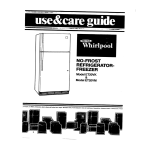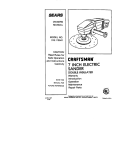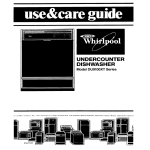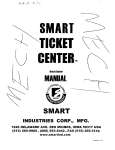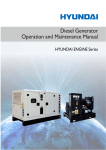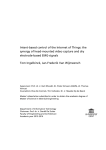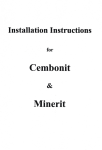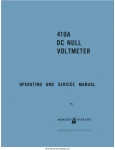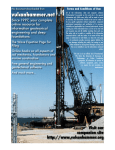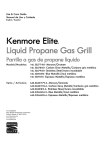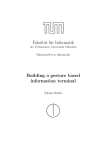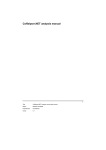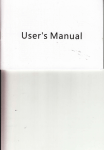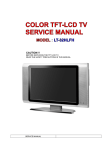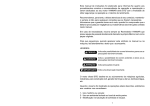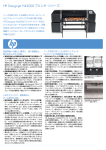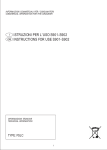Download IHI IDH-J22 Field Service Manual
Transcript
this document downloaded from vulcanhammer.info the website about Vulcan Iron Works Inc. and the pile driving equipment it manufactured Terms and Conditions of Use: All of the information, data and computer software (“information”) presented on this web site is for general information only. While every effort will be made to insure its accuracy, this information should not be used or relied on for any specific application without independent, competent professional examination and verification of its accuracy, suitability and applicability by a licensed professional. Anyone making use of this information does so at his or her own risk and assumes any and all liability resulting from such use. The entire risk as to quality or usability of the information contained within is with the reader. In no event will this web page or webmaster be held liable, nor does this web page or its webmaster provide insurance against liability, for any damages including lost profits, lost savings or any other incidental or consequential damages arising from the use or inability to use the information contained within. This site is not an official site of Prentice-Hall, Pile Buck, or Vulcan Foundation Equipment. All references to sources of software, equipment, parts, service or repairs do not constitute an endorsement. Visit our companion site http://www.vulcanhammer.org INSTRUCTION MANUAL FOR ESEL P LE HAMMER MODEL W 2 2 Ishikawajima-Harima Heavy Industries Co., Ltd. Mass-Produced Macineny Division TOKYO JAPAN 1970.7 PRECAUTIONS FOR PILE HAMMER OPERATION The following items should be strictly observed when operating the pile hammer. Extreme care should be taken as negligence will not only damage the hammer itself, but also inpure t h e operators and nearby people, furthermore damage the surrounding buildings. / 1; 1. 1 1 MAX. PENETRATING RATE PER BLOW When t h e ground is soft and low in resistance, or the pile diameter is small, let the banner free-fall several times, before starting ~ i o r m a operation. l In other words, pull down the The wire rope con~iectingthe lower part of the hammer and the pile cap will break if the prevent such serious damage. conduct free-falling without a fuel supply or operate the hammer with little fuel siipply l a 1,; 11 I: 2. Do not run the rope of tlie [ripping devlce faster than 12 rn per minute. Especially when setting ttir: Iiamrnel o n the pile, stop the winch temporarily and set the pile. Excessive rope speed w ~ l ldamage the tripping device resulting in falling of the hammer, and careless settulg of the hammer will cause a wild blow. 3. 4. 5. 11 I PILESET-UP When setting the pile. be careful not to let the pile come in contact with the hammer. Set the hammer center so tllat it comes in line with the pile center. Otherwise, the pile will sway causing damage or an accident. I - HAMMER GUIDE AND LEAD Maximum clearance between the harnn-rer guide and the lead is 7 mm on both sides (3.5 rnm o n one side). The clearance above 7 mni will result in accidental falling of the hammer o r breakage of tlie unit. It is very dangerous to use the lead, bent, worn, or improperly jointed, because such a lead will only cause damage. I '1 1 !I LIMlTATION O F THE HAMMER OPERATION upper piston jumps above 7.6 ni, lower the volume of the fuel intake.) C o n t i n ~ ~ o u s operation under these c i r c ~ ~ m s t a ~ iwill c e s cause severe damage t o the piston and cylinder. 11 ' : ROPE SPEED O F THE TRIPPING DEVICE 6. HOlSTING O F THE HAMMER When the hammer is hoisted by the tripping device, make sure that the locking device is in the proper position and hold down the hooks, and the hooks carry the hoisting seat of the upper cylinder before Iioistlng. Do not go under the hammer or put your hands between the hammer and the pile. If necessary, insert a wood block. I 1: 1, II 7. DAILY INSPECTION AND CLEANING Start the operation after making sure that all the bolts and nuts are tight, and fastened with safety wire. Be sure to replace the bolts if the threads are abraded. If the worn bolts are left as they are, they may cause damage. Always keep clean the conbustion chamber, the concave surface of the upper and lower cylinders. I The care exercfi, extend their useful ld responsible for the 01 suggestions on everyd instructions. Identification of Pile A plate is attac showing the model a ordering parts for thc on correspondence, t model and serial nun PREFACE The care exercised in the operation and maintenance of IHI Diesel Pile Hammers will extend their useful life and insure higNy satisfactory and dependable service. To those responsible for the operation and maintenance of the pile hammer, this manual contains suggestions on everyday operation and care as well as periodical lubrication and maintenance instructions. Identification of Pile Hammer A plate is attached to the front of the unit showing the model and serial number. When ordering parts for the hammer, or when carrying on correspondence, be sure to mention the model and serial number of the hammer. I n n lI IS n nfi n7 WHEN ORDERING PARTS TO MENTION BE SURE /j CONTENT ; I I i 1 - Chapter 1 INTROD UCTlON . . . . . . . . . . . . . . . . . . . . . . . . . . . . . . . . . . . . . . . . 1-1 1-2 1-3 1-4 I I 1 i I ; Chapter 2 Outline . . . . . . . . . . . . . . . . . . . . . . . . . . . . . . . . . . . . . . . . . . . . Specifications . . . . . . . . . . . . . . . . . . . . . . . . . . . . . . . . . . . . . . . . Structure. . . . . . . . . . . . . . . . . . . . . . . . . . . . . . . . . . . . . . . . . . . . Theory of Operation . . . . . . . . . . . . . . . . . . . . . . . . . . . . . . . . . . . . . STRUCTURE AND FUNCTION OF EVERY PART ................ HammerBody . . . . . . . . . . . . . . . . . . . . . . . . . . . . . . . . . . . . . . . . Starting Device.. . . . . . . . . . . . . . . . . . . . . . . . . . . . . . . . . . . . . . . 2-1 2-2 ...................................... Chapter 3 LUBRICATING OIL, FUEL . . . . . . . . . . . . . . . . . . . . . . . . . . . . . . . . 3-1 Upper Piston Lubricating Oil . . . . . . . . . . . . . . . . . . . . . . . . . . . . . . 3-2 Lower Piston Lubricating Oil . . . . . . . . . . . . . . . . . . . . . . . . . . . . . . 3-3 Lubricating Instructions . . . . . . . . . . . . . . . . . . . . . . . . . . . . . . . . . . 3-4 Fuel . . . . . . . . . . . . . . . . . . . . . . . . . . . . . . . . . . . . . . . . . . . . . . Chapter 4 4-1 4-2 4-3 4-4 4-5 4-6 4-7 48 4-9 9' -I 1 .: I; Chapter 5 PERIODICAL CHECKING AND MAINTENANCE 5- 1 5-2 5-3 5-4 5-5 I 1. I ! Chapter 7 MAINTENANCE STANDARD I .............................. 7-1 Disassembly and Reassembly of the Fuel Pump . . . . . . . . . . . . . . . . . . 7-2 How to Repair the Plunger and Barrel . . . . . . . . . . . . . . . . . . . . . . . . 7-3 Disassembly and Reassembly of the Nozzle . . . . . . . . . . . . . . . . . . . . 7-4 Adjustment of Injection Pressure of the Nozzle . . . - . . .- - - .- 7-5 .!I 1 .................................... TROUBLESHOOTlNG 1 . .-................ Daily Routine . . . . . . . . . . . . . . . . . . . . . . . . . . . . . . . . . . . . . . . . Routine at Every 250 Hours of Net Running Time . . . . . . . . . . . . . . . . Routine at Every 500 Hours of Net Running Time . . . . . . . . . . . . . . . . Routine at Every 1,000 Hours of Net Running Time . . . . . . . . . . . . . . Routine at Every 3,000 Hours of Net Running Time . . . . . . . . . . . . . . Chapter6 , : .............................. Fixing Procedure of the Dieselpile Hammer . . . . . . . . . . . . . . . . . . . . Inspection and Lubrication before Starting the Operation. . . . . . . . . . . . Pileset-up . . . . . . . . . . . . . . . . . . . . . . . . . . . . . . . . . . . . . . . . . . Starting . . . . . . . . . . . . . . . . . . . . . . . . . . . . . . . . . . . . . . . . . . . . Cautions for Starting . . . . . . . . . . . . . . . . . . . . . . . . . . . . . . . . . . . . Cautions during Running . . . . . . . . . . . . . . . . . . . . . . . . . . . . . . . . Stopping . . . . . . . . . . . . . . . . . . . . . . . . . . . . . . . . . . . . . . . . . . . . Cautions for Stopping . . . . . . . . . . . . . . . . . . . . . . . . . . . . . . . . . . Important Items on Operation. . . . . . . . . . . . . . . . . . . . . . . . . . . . . . OPERATION AND HANDLING Chapter 8 "' ServiceableLiitoftheWearingPart ........................ APPENDIX . . . . . . . . . . . . . . . . . . . . . . . . . . . . . . . . . . . . . . . . . . . . 8-1 Pile Resistance . . . . . . . . . . . . . . . . . . . . . . . . . . . . . . . . . . . . . . . . 8-2 Selection of Hammer Capacity. . . . . . . . . . . . . . . . . . . . . . . . . . . . . . 8-3 Pile Size Suitable for the IHI Diesel Pile Hammer . . . . . . . . . . . . . . . . 1 1 2 2 5 5 6 \ I Chapter1 1 1-1 Outline For the conventional impact atomization type diesel pile hammers, the fuel pump is operated when the upper piston falls, the fuel is injected and stays on the top surface of the lower piston. When the upper piston strikes the lower piston, the fuel disperses being atomized, mixes with the high temperature and high pressure air which is compressed by the upper piston, and is ignited. Therefore, when the temperature of the machine parts (especially of the top surface of the lower piston) rises after running for some time, the fuel supplied onto the top surface of the lower piston is gasified and ignited before the lower piston is struck. So that, the falling speed of the upper piston is reduced and the striking force is lowered. This was the weak point of the conventional diesel pile hammers. I: I: II I INTRODUCTION On the other hand, for this nozzle atomization type diesel pile hammer, the following combustion system is adopted. That is, the fuel pump is operated by utilizing the pressure of compressed air in the cylinder, which becomes high when the upper piston falls, and the fuel is injected by the nozzle, being atomized, into the compressed air of high temperature and high pressure just after the upper piston strikes the lower piston. i Therefore, the fuel can be ignited without fail even when the ground is weak and the upper piston cannot strge the lower piston strongly because the pile is driven into the ground only by the pneumatic pressure of the air which is compressed by the falling upper piston. So, continuous striking performance is high and the striking force is not lowered by preignition even after continuous operation for a long time. Besides, as this pile hammer is of air-cooled type, handling and maintenance are quite easy, and a trouble such as freezing of cooling water in winter is completely eliminated. > I 1-2 Specifications 1, Model 1DH-J22 /j Overall length mm 4,25 1 Total weight kg 4Q 10 i Upper piston weight kg 2,200 L i blow/min. Number of blow kg.m Energy out-put per blow I 11 I 1- 40 - 7 0 5,500 Fuel consumption (Kerosene or Heavy Oil) l/h. 14 Lubricating oil consumption l/h. 15 Fuel tank capacity I 50 Capacity of lubricating oil basin I 7 J I - 1 - Structure Model 1DH-J22 diesel pile hammer consists of the upper cylinder, lower cylinder, upper piston which moves up and down in the cylinder, lower piston which is housed in the lower cylinder, fuel pump driving device,. Bosch type fuel pump, nozzles, fuel stopping device, fuel tank around the top of the lower cylinder, fuel filter, starting d&ce, etc. The upper part of the upper piston forms a lubricating oil basin, and oil is sprinkled out through the small oil holes little by little during operation and lubricates the inner surface of the cylinders. The fuel pump and the pump driving device are mounted in the middle in front of the lower cylinder and are driven by the pneumatic force of the air which is compressed by falling of the upper piston. Thus, they inject fuel into the combustion chamber through the nozzles by atomizing it. The starting device moves vertically along the lead pipes of the piling frame. This is used for lifting the upper piston when starting the pile hammer and also for lifting the pile hammer itself at the time of erecting the pile. Theory o f Operation (refer to F. 1-2, F.2-8) (1) Starting (Free Falling) When the starting device is hoisted up, the upper piston moves upward being hooked by the pawl of the starting device. When the upper piston reaches the specified height, the tripping mechanism works and the upper piston falls automatically. (2) Compression -and Striking The upper piston, which falls, closes the air intake and exhaust ports of the cylinder, keeps on falling by compressing the air in the cylinder, strikes the lower piston at last and thus drives the pile into the ground by the impact force caused at that time. (3) Combustion By the pneumatic pressure at the time when the upper piston strikes the lower piston, the fuel pump works and injects fuel intb the cylinder through the two nozzles. Combustion begins at the same time as fuel injection, and the pressure in the cylinder rises. This combustion pressure works upon the fuel' pump driving device and keeps it injecting the fuel. Besides, it also works upon the upper piston to make it jump up and presses the lower piston to promote penetration of the pile. (4) Exausting When the upper piston moves up, the exhaust ports open, and the combustion gas in the cylinder expands and is exhausted. (5) Suction of Air When the upper piston further moves up passing the exhaust ports, fresh air is sucked into the cylinder through the exhaust ports, and thus the combustion gas is replaced with fresh air. Chapter 2 STRUCTURE AND FUNCTION OF EVERY PARTS Hammer Body (see F. 2-1) 2-1 (1) Upper Piston (Ram) The upper piston is provided with 6 piston rings and a catch ring. A catch ring is for preventing the upper piston from jumping out of the cylinder in case the combustion force is unusually strong and the piston jumps up abnormally. The top of the piston is provided with the lubricating oil basin. By the oscillation of lubricating oil during running, it is sprinkled out through the small oil holes to lubricate the piston. Besides, a flange is cut near the middle of the piston(somewhat toward the top)to apply the pawl at the time of starting. The space around the striking part at the bottom serves as the combustion chamber. (2) Lower Piston (Anvil) The lower piston is provided with 5 piston rings. Between the top and the second piston rings, a groove is provided to hold the superheated steam cylinder oil for lubricating the lower cylinder. The top of the lower piston has a concave spherical surface which watches the striking surface of the upper piston. (3) Upper Cylinder The upper cylinder is provided with a groove for fixing the catch ring which is to prevent the upper piston from jumping out. On the leader side, a pawl groove is cut through which the pawl of the starting device travels. On the outside of the upper cylinder, a lifting hook seat is fixed by welding for lifting the hammer body by the starting device. Besides, the upper and lower cams for automatically lifting and dropping the upper piston at the time of starting are also welded. The upper and lower cylinders are combined and centered by the spigot and socket joint. (4) Lower Cylinder Fig. 2-1 In the lower part of the lower cylinder, a cylinder liner for the lower piston is inserted. To prevent the lower piston from falling off, an inner end ring of split type and an outer end ring to fix the inner end ring are provided. Besides, a rubber ring is fitted to the outer end ring in order to absorb the shock between the lower piston and the lower cylinder I I I On the outside near the top of the lower cylinder, a fuel tank is provided. On the outer surface of the lower cylinder, guide jaw mounting seat for sliding the pile hammer body and mounting seats for various component parts of the firing mechanism are fixed. On the periphery of the lower cylinder, four decompression holes are provided so that the combustion gass will escape when abnormal continuous striking occurs and thus to prevent the lower piston from striking the inner end ring and to avoide damage. l1 1 2-2 I > 1 1 I II I 1! ' > i I , Starting Device (1) Lifting of Hammer Body (see F. 2-2, F. 2-3) When the locking device is not pushing the left hook as shown in F. 2-2, the right and left hooks are open because of the torsion springs which are provided to the shafts of both hooks. However, when the lever is pulled as shown in F. 2-3, the locking device pushes the left hook and the right hook is moved by the connecting rod. Thus, the lifting hook seat is held by the right and left hooks and the hammer body is lifted up. As a ratchet gearing is provided to the locking device, the lever returns to the original position being pulled by the returning rubber when the rope is released, but the position of the locking device does not change. When the rope is pulled again, the locking device turns and the left hook is not pushed. Thus the operation is repeated by pulling and releasing one rope. (2) Lifting of I: When the st cam of the upper fixing the fishplat connecting the ce cam, the starting tip of the pawl. A is pushed in th fore, the pawl do When the sf of the upper cylil center A comes tl Then, because of the center A is pi released from thl automatically. (2) Lifting of Upper Piston (see F. 2 4 , F. 2-5) When the starting device is moved downward, the tripping lever touches the lower cam of the upper cylinder and moves upward (arrowhead a ). When the center A for fixing the fishplate to the tripping cam comes to the right side of the line which is connecting the center B for fixing the pawl and fishplate and the center C of the tripping cam, the starting device is pulled up and the flange of the upper piston is hooked to the tip of .the pawl. Thus, a force is applied in the direction of the arrowhead b , the center A is pushed in the arrowhead direction c , the fishplate contacts the stopping bolt, and therefore, the pawl does not move downward and the upper piston is lifted as it is. When the starting device is lifted up as it is, the tripping lever touches the upper cam of the upper cylinder as show in F. 2-5, and moves downward (arrowhead d ). So, the center A comes to the left side of the line which connects the center B and the center C . Then, because of the force applied to thc tip of the pawl in the arrowhead direction e , the center A is pushed in the arrowhead direction f , the pawl moves downward being released from the flange of the upper piston. Thus, the upper piston falls down automatically. Lower c. II Tripping lever Fig. 2-4 Fig. 2-5 I I If the starting device is not fully moved down before lifting the upper piston or " when the tripping lever contacts somethmg el'se and the center A comes to the left side of the line which is connecting the center B and C, the pziwl moves downward and is released from the flange of the upper piston. Therefore, it is impossible to lift the upper piston. \ (3) The right hook cam is bolted to the right hook as shown in F. 2-6, and a .. , safety cam for preventing an acclaenxal explosion is fixed to the end of the tripping lever shaft by a key. When the right hook holds the lifting hook seat for lifting the hammer body (arrowhead a ), the right hook cam moves clockwise to push up the safety cam (arrowhead b ) and moves the tripping cam counterclockwise (arrowhead c ). So, the center A is forcibly fixed on the left side of the line between the centers B and C as shown in F. 2-5. Therefore, when the starting device is lifted, the pawl is . . released from the upper piston Ilange and the upper piston is placed dire( on the lower piston when starting device is lifting the hammer body. Thus, the accidental explosion is completely eliminated when the hammer body is placed on the pile. 1 (.* t (oy , '.r,,"7 1 . . ,. . . Cam ta l r-, , I' 2-3 7-r. ^"/..." / I",.".. W K 6 7'IW L L-- NVYn LLIRL Fig. 2-6 Firing Mechanism (1) I Structure of t h part of the fud increases and e driving piston 1 For sealing th4 the piston is fiI sprinkled to lu, pump- I rripp~nf am Dr;I @ Fuel Pump Safety Bar for Preventing Accidental Combustion (see. ! I 2 . I Fuel Pump Fuel Piping Diagram Pwnpdriviy deb ice Fig. 2-8 Section (2) Fuel Pump Driving Device and Fuel Pump @ Fuel Pump Driving Device Structure of this device is as shown in F. 2-8, and it is assembled into the lower part of the fuel pump to form an integrated structure. When the pressure of the air increases and exceeds the force of the plunger spring @ of the fuel pump, the pump driving piston @ is pushed up and thus operates the plunger @ of the fuel pump. For sealing the compressed air, piston rings @ are provided. The concave part of the piston is filled with lubricating oil. When the piston moves up and down, oil is sprinkled to lubricate the inner wall of the cylinder @ and the inside of the fuel P-P. @ Fuel Pump (see F. 2 8 ) Structure of the fuel pump is as shown in F. 2 8 , and it is of Bosch type ones. Fuel which is fed from the fuel tank through the fuel filter entersinto the suction chamber @ around the plunger cylinder @) through the intake port @ For air bleeding on the inlet side, loosen the air bleeder screw above the inlet port @ Fuel which has entered into the suction chamber @ around the plunger cylinder @ goes into the of the plunger cylinder. AS chamber @ at the top of the plunger through the port the plunger @ is pushed up by the pump driving piston, the fuel in the top chamber @ is forced into the nozzles by pushing the delivery valve (check valve) @ open. a . 0 The plunger @ is provided with a special shape of groove which coincides with the port of the plunger cylinder @ . The coinciding amount of the groove and port can be varied by rotating the plunger. 0 0 If the plunger is rotated to such position that the groove and the port do not coincide at all, the fuel in the chamber at the top of the plunger is forced out to the two nozzles as a whole (about 5cc). If the plunger is at a position that the groove coincides with the port O , a part of the fuel is returned from the chamber at the top of the plunger to the suction chamber @ through I the port when the plunger is pushed up. The amount of returning fuel is in proportion to the coinciding amount of the groove and the port 0 , and thus the amount of fuel which is pushed out to the nozzles is adjusted. It is also possible to adjust the rotating angle of the plunger so that the whole fuel is returned to the suction chamber and make the amount of fuel pushed out to the nozzles zero. 0 0 The plunger @ is meshing with the control sleeve @ . On the outer surface of the control sleeve @ ,gear teeth (pinion) are cut, and the pinion is meshing with the control rack @ . The plunger is rotated by moving the control rack @ rightward or leftward, is adjusted. and thus the coinciding amount of the plunger groove and port 0 The control rack is connected to the fuel regulating device which is mounted on the outside of the fuel pump. The control rack @ can be moved rightward and leftward by . When the pully is turned clockwise, the fuel volume increases, rotating the pully and it decreases when turned counter clockwise. No~;t-LP holder body \ Lock nu$ Fig. 2-9 - 10 Nozzle - I of wire nettings. The filtering accuracy of element is 20 microns. (6) Fuel Tank (see F. 2-12) I 1: The fuel tank is provided near the top of the lower cylinder. The locking spindle (fuel cock) is provided above the fuel outlet port of the fuel tank. On the locking spindle seat, shallow slot and deep slot are cut. Before starting the pile hammer, be sure to pull up the locking spindle and engage it to the shallow slot. Thus, the rubber valve at the bottom of the fuel tank opens and the fuel flows to the fuel pump. Applicable Seasor Manufacturer Shell Oil Mobil Oil ESSO Oil Gurf Oil Corp. II Fig. 2-12 Fuel Tank 3-3 Lubricating I n 11 1 [ I 1 I \ (2) Lower1 (3) Fuel Pu I I I I - Chapter 3 Applicable Season - 3-2 (I o Spring o Autumn o Winter Shell Rotell Oil No.40 Shell Rotell Oil No50 Mobil Oil CO. Delvac Oil 940 ESSO Oil Essolub HD-40 Gurf Oil Corp. Gulf Dieselub HD-40 Gulf Dieselub HD-50 Gulf Dieselub HD-30 I I I I' ' - Delvac Oil 950 Delvac Oil 910 Essolub HD-50 Essolub HD-20 Lower Piston Lubricating Oil (Superheated Cylinder Oil) o Spring o Summer o On the operation where it takes over one hour to drive one pile. Shell VaIvata Oil No. 79 Shell Valvata Oil NO. 85 Mobil Oil Mobil600W Super Cylinder Oil Mobil600 W Super Cylinder Oil ESSO Oil Sylesso 300 Sylesso 300 Gurf Oil Corp. Gulf M CyIinder Oil Gulf M Cylinder Oil Lubricating Instructions .-...-.....Supply upper piston lubricating oil (required quantity is (1) Upper Piston (2) Lower Piston (3) Fuel Pump Driving Cylinder At every 20 minutes of net running time or after driving every pile, supply lower piston lubricating oil to 4 grease nipples by a grease pump by 10 strokes per every nipple. 7 1) every day before starting. If lubricating oil stops to come out from the discharge ports of the upper piston during running, stop the pile hammer at once and supply lubricating oil. I i o Severe cold region (-10 - -20°C) Shell Oil II i , o Summer o On the operation where it takes over one hour to drive one pile. Manufacturer Applicable Season 3-3 LUBRICATING OIL, FUEL ........... At every 20 minutes of net running time or after driving every pile, supply lower piston lubricating oil to 4 grease nipples by a grease pump by 10 strokes per every nipple. - 13 - inspection plug, smear inspection plug lubricant (Molibdenum Disulfide or Graphite) and screw the plug in. Starting Device At least at every one week, supply several drops each of upper piston lubricating oil by a hand oiler to every sliding part and moving part of the starting device. Besides, to the grease nipple of the pulley, supply mineral grease at every one week by a grease pump by 10 strokes. (6) Stopping Device At least at every one week, supply several drops each of upper piston lubricating oil by a hand oiler to every sliding part of the stopping lever and push rod. (7) Lead Pipe Check every day before starting the hammer and smear mineral grease to those portions where grease is becoming short. I, /i i1 I ,- 3-4 Fuel Oil ( I ) For all the year round, it is recommended to use light oil (light oil for diesel engines, light oil of JIS No. 1, 2 and 3, etc. Any kind or brand will do.) I / I: (2) It is also possible to use heavy oil A or heavy oil for diesel engines. (3) It is also possible to use kerosine (any kind or brand). However, when using kerosine, mix about 20% of upper piston lubricating oil to improve the lubricating effect. Notes: 1) Always use clean fuel oil, and keep fuel oil free from mixing of dust, rain, etc. 2) When supplying fuel oil, be sure to clean the oil inlet beforehand to prevent dust or foreign matters from entering. 'I Fixing Procedure (1) Unload the h the truck. When u the wire ropes (twc And when hoisting 'center of the gravil (5) Fixing the protective wire rope I I II Run the protective wire rope through the hook on the lower part of the cylinder and hook of the pile cap. Provide sufficient slank in the wire so that the lower piston can slide down 15 - 20 cm. The specified wire thickness is over 20 mm. 4. 20 Wt're trip cic~xed ON three positions) ZD CfLp detail Fig. 4 4 Inspection and Lubrication before Starting the Operation (1) Remove the following shipping fixtures. Upper Upper Lower Upper Lower , I T-/ protectin$ cup cylinder protecting cap cylinder protecting plate cylinder exhaust plug piston safety bolt piston safety fixture Points to inspect and tighten daily before starting operation. (2) (a) (b) (c) (d) (e) (3) Conical hexagon nuts on the guide jaw of the lower cylinder. . Sufet;f fixrur* Fuel pump f ~ nuts. g Conical hexagon nuts fixing Fig. 4-5 the lower cylinder and the end ring. Bolts connecting the upper cylinder and the lower cylinder. Bolts and nuts for the guide gib of the starting device. Fill fuel daily before starting operation. The fuel tank capacity is about 50 1. (4) Loosen the drain plug at the bottom of the fuel tank and drain the moisture in the fuel tank once a week. (5) Fill the upper piston oil basin with lubricating oil in the following procedure. (a) Move down the tripping device slowly so that the pawl engage the ring groove of the upper piston. (b) Hoist the upper piston by the tripping device so that it protrudes about 2cm from the upper cylinder. - 16 - Fig. 4-6 Applying grease on the lead Apply cup grease slightly on the lead, guide jaw and guide gib. They wiU wear rather quickly without grease application. (9) Cleaning of the lower piston hollow Remove the inspection plug of the lower cylinder inspection hole and insert the cloth-wound cleaning wire (attached tool) in order to remove dirty oil, moisture and other dust particles from the lower piston hollow. Then, let the upper piston go down and clean the hump at the end of the upper piston by inserting the cleaning wire from the inspection hole. After cleaning, replace the inspection plug. (Caution) Check to see if the thread of the inspection plug is oily. An oily plug is hard to remove because it tends to burn and stick during operation. Therefore, apply MOLYBDENUM DISULFIDE or GRAPHITE to the threads of the inspection plug. Pile Set-up (1) Sling the rope around the pile to bring the pile near the mast. (Caution) (a) Do not draw the pile positioned far from the mast because the mase will fall over. (b) Put down the hammer when drawing the pile. (c) If the pile does not move when drawing the pile from far, sling the rope at the mast side from the center of the pile and draw the pile raising slightly on the mast side. Move the position of rope to 1 m from the head of the pile when the pile comes near the mast. (2) Setting-up the pile. Set the head of the pile at the point when the pile is to be driven. (3) Set the locking device of the starting device to the locking position. (Caution) (a) When hoisting the hammer with the starting device, check to see that the locking device is set to the normal position to support the hook and that hook 6olds the cylinder hoisting seat. (b) In the case when one of the two hooks holds the hoisting seat at the time of hammer hoisting, it is because that the connecting rod or bolts are bent. In this case, replace or repair them. Otherwise, the hooks will be off and the hammer will fall down. (8) , \ Fig. 4-9 (4) (In case of Con( Spread a straw 1 Set the pile han (Note) Do not sei pile drawi, device, an1 hammer b Reset the lockir Put the locking fuel cock. (Fin Loosen the air 1 to deaerate the air bleeder screl (Finish this ste] (Note) Be sure tc when the also wher Pull the resettu at the position Rotate the fue: Lift up the sta When it is lifte upper piston, i time, return tk more than 8 0 rod device H?mme? Hoistin$ > < I Move the startj piston. , C y L ~ d e r h o ~ s & ' ~seat ,Cowtectly Set the pile up Uppep Arton ~ o i r t i ~ Fig. 4-10 Operate the hammer hoisting winch drum and raise the hammer a little above the head of the pile. If the pile pen the pile is stru pile hammer t piping, and it If continuous is less than 1C increased. If piston might j (5) Set the pile up vertically by rotating or moving the mast forward and backward. (6) (In case of Concrete Pile) Spread a straw mattress or something as a buffer on the head of the pile. (7) Set the pile hammer slowly down on the pile. Do not set up the pile from the locking device side because the pile or the pile drawing rope may catch the ratchet, locking device of the starting. device, and then these devices rotate resulting in the sudden fall of the hammer by opening of the right and left hooks. (8) Reset the locking device to the starting position. (1) Put the locking spindle at the top of the fuel tank into the shallow slot to open the fuel cock. (Finish this step before erecting the pile in position). (2) Loosen the air bleeder screw above the fuel inlet connector bolt of the fuel pump to deaerate the inside of the fuel pump. When it stops to spurt bubbles, tighten the air bleeder screw completely. (Finish this step before erecting the pile) Be sure to deaerate before the initial operation after delivery and every time when the pile hammer is newly brought to a different construction site and also when the fuel is newly supplied after completely exhausting. (3) Pull the resetting rope of the stopping lever and confirm that the stopping lever is at the position for running. (4) Rotate the fuel regulator pully and adjust the fuel delivery rate to about ?4. (6) Lift up the starting device by the winch (hammer lifting drum). (see Fig. 4-11) When it is lifted about 90 cm,the pawl of the starting device is released from the upper piston, and then the piston falls down and the hammer is started. At the time, return the starting device immediately to its standard position by lifting it more than 80 cm above the hammer body. (7) If the pile penetrating rate per blow is less than 10 cm, combustion is repeated and the pile is struck continuously. However, for the initial starting after bringing the pile hammer to a new construction site, air is sometimes contained in the fuel piping, and it does not sometimes start by only one starting operation. increased. If the fuel injection amount is set too large from the beginning, the upper piston might jump out of the upper cylinder. I 19 - When the gro~ resistance is to is too light, th the ground mc one blow. In such case, 1 stoppirig lever combustion b j ing the fuel in: the fuel delive pile penetratio than about 10 If the pile pen more than 20 pile hammer rr breakage of th damage or def outer end ring (9) Fig. 4 1 1 When continuous striking begins, adjust the fuel delivery rate so that the jumping height of the upper piston becomes about 2.0 m and begin continuous operation. When striking and moreover, ing the fuel re the fuel regulr Otherwise, dis rate is to be a .until you can delivery rate ( utions during I Cautions for Starting (1) Use the starting device at the upward and downward travelling speed of 10 - 12 m/min. (2) Model IDH-J22 diesel pile hammer has excellent ignitability. Therefore, if it is started by injecting the fuel at the maximum fuel delivery rate in such cases when lubricating oil for the upper piston sliding surface or superheated steam cylinder oil for lubricating the lower piston is staying o n the concave surface of the lower piston excessive combustion pressure (explosion) may be caused, and a serious accident such as jumping out of the upper piston may result. Therefore, when starting in such cases as mentioned below, pay full attention to adjust the fuel regulator pully so that the fuel delivery rate for starting ignition becomes less than 'A or pull out the inspection plug at the lower cylinder and wipe the concave surface of the lower piston with a piece of clean cloth before starting. (a) (b) (c) (d) (e) Starting for the initial operation after delivery. Starting for the initial operation after newly bringing into a construction site+ Starting just after oiling to the upper and lower pistons. Initial starting in the morning after stopping overnight. Starting after stopping for more than 30 minutes. When the pile than 4m dista After starting the hammer b from touchinl During run& fuel so that tl When the upg suspend the a If the ground blow for the stopping rope striking withc to the adequz I) 3) When the ground is too weak and the resistance is too small or when the pile is too light, the pile may penetrate into the ground more than about lOcm by In such case, pull the rope of the fuel stopping lever and strike without combustion by several blows by keeping the fuel injection stopped. Or, set the fuel delivery rate small so that the pile penetration per blow becomes less than about 10 cm. If the pile penetration per blow becomes more than 20 cm,serious damage to the pile hammer may be caused such as breakage of the pile cap hanging ropes, damage or deformation of the inner and outer end rings, and so forth. (4) When striking without combustion, pull the fuel stopping lever to stop fuel injection, and moreover, keep the setting of the fuel delivery rate at ?4 through 213 by adjusting the fuel regulating pully. Never perform striking without combustion by keeping the fuel regulator pulley turned fully counterclockwise (fuel delivery rate is zero). Otherwise, disorder in the fuel pump may be caused. Besides, as the fuel delivery rate is to be adjusted by pulling the rope, repeat practice many times beforehand until you can fully understand the relation between the rope movement and the fuel delivery rate (movement of the control rack). (1) When the pile hammer is running, do not approach the hammer but stay at more than 4m distance from it. (2) After starting, immediately, lift up the starting device more than 80 cm higher than the hammer body, and keep it at that height during running. By this, it is prevented from touching the ram during running and to cause troubles. (3) During running, be sure to keep on holding the fuel regulator rope and control the fuel so that the jumping height of the upper piston does not exceed 2.5 m. (4) When the upper piston jumps up abnormally, pull the fuel stopping rope at once and suspend the operation. (5) If the ground becomes soft suddenly during operation and the pile penetration per blow for the succeeding blows becomes more than about 10 cm, pull the fuel stopping rope at once to stop the operation of the fuel system and to perform striking without combustion, or keep on running by adjushhg the fuel delively rate to the adequate value. (6) When the tip of the pile comes to a hard ground and the pile penetration per 10 becomes less than 5 mm, stop the operation and change the hammer for one of larger capacity. Otherwise, the hammer might be damaged. .. . . . . . .. . 8 . Important Ite /%ve ~ . . (1) .._ beam When futishing to drive a pile to the specified depth and proceeding to drive the next pile (When pile driving is to be continued): (b) Stop the fuel supply by pulling the rope of the fuel stopping lever and stop the hammer. . , ... .. . . . . . . channel Fig. 4-13 .. ' j : . '! . . ..! > : , . Do not use dangerous The servicz * Use a le L * Adjust t I-: * The cle: when t l ... . . . (2) ..:# ' (a) Do not dr In other u the pile, ar center line. Stopping (1) stop the 0, b y pulling1 stopping dl ( ' .. .. . ho~i~o&dLy at a consfant sped a l o y t/ie ,i~i$ontill Q X ~ L . .. ,: How to ~ i a s u r e , t h e . ~ $~ eo n e t e r t i nR~ ... . . . . ,. .. . Put the locking device of the starting device to the 1ocking.position and lift:up the hammer body by the winch, and then lift the bottom end of the pile cap . . '. to about 50 cm above the ground surface. , / .:. : ' . (d) Move the piling frame t o the position for driving the next pile: ..: . . . Place the hammer on the wooden plate on'the ground. . (e) Prepare to erect the next pile. (c) (2) . ' 1 I _ . . . .... . .. . . : . : . ,.. . '.' When finishing the pile driving work: (a) Stop the fuel by pully the rope of the fuel stopping lever and stop the hammer. (b) Put the protective cover on the upper cylinder. Take care cylinder a (c) Screw the threaded plugs into the exhaust ports. (a) Iftl will The (b) Plac plat perf to 1 hart (3) Cautions for Stopping (1) In general, stop the operation by pulling the fuel. stopping rope. Do not:stop the operation by making the fuel delivery rate zero by pulling the fuel control rope and turning the fuel regurator pulley fully counterclockwise. (2) However, when the operation does not stop even if the fuel stopping rope is pulled I1 stopping device is out of order.) Important items on Operation 4-9 (1) Do not drive the hammer without proper alignment In other words, the center of the hammer has to hit positively the center of the pile, and the head of the pile has to be flat and centered with the hammer center line. I (2) Do not use a worn lead as the hammer will come off the lead and fall. It is very dangerous t o use a worn or bent lead. The servicable limit of the lead width is * Use a lead of the following specification 398 - 400 mm Lead .outside dimension * Adjust the hammer guide clamp according to the following Hammer guide clamp inside dimension 401 - 405 mm * The clearance between the lead and hammer guide clamp should not exceed 7 mm when the hammer is pushed to one side. (-7 I/ I II /I ! Fig. 4-14 398-4W (Lead o u f ~ i d edim ension). Lead dimension and adjusting clearance (a) If the sand particles, steel chips or welding slag is attached to the lead, they will fall down, from vibration, into the cylinder. Therefore clean the lead thoroughly to remove them. (b) Place the protecting cap on top of the upper cylinder, attach the protecting plate, and plug the exhaust port, when the welding or other maintenance is performed on the hammer above the exhaust port with the hammer attached to the lead. Remove the welding slag and steel chips from the lead and hammer after welding is finished. Negligence will cause the pawl of the starting device to engage in the wrong position of the upper cylinder, score the upper piston and break the pawl. Then the cylinder surface will be damaged by the.broken pieses of the pawl. (a) When the laking device of the winch brake is set incompletely, the brake locking device will be disconnected, causing the starting device to fall from vibration. Therefore, make sure it is set completely. (b) The upper piston will move up and down by the compressed air inside the cylinder for about 10 - 26 seconds after the operation has stopped. Therefore, do not let the starting device down until after the vibration has stopped. Cracking of the Lower Cylinder Extreme care should be taken during operation as the lower cylinder may crack when the pile hammer is subjected to the following conditions. (a) The center of the hammer is not aligned with that of the pile (or pile cap). (b) The head of the pile (pile cap) is not flat. (c) The hammer is operated continuously when the pile penetration is less than 5 mm per 10 blows. (d) The hammer is operated continuously without supplying lubricating oil by stopping the hammer every 15 - 20 minutes. A worn or broken damper rubber ring is used. (e) (0 The hammer is operated without cutting fuel oil, even when the pile penetration is excessive (more than 100 - 200 mm per blow). Never pad (weld) the pawl end of the tripping device and the craw of the rightlleft hooks for the hammer. The chipped pawl or hook is extremely dangerous to the operation. (a) Measuring The mear piston fa1 number c but it giv The rela blows. Chapter 5 , , PERIODICAL CHECKING AND MAINTENANCE For Model IDH diesel pile hammers, periodical checking and maintenance are required as explained below. The following running hours are for the operation at a place of normal conditions. If the actual condition at site. If any one of the bolts and nuts as listed below is becoming loose or any locking is missing, retighten the loosened ones. (1) Part No. (2) Part Name Remarks Q't Y NUT, for guide jaw 12 2 5155015 BOLT, for guide grib 8 3 J151007 NUT, for end ring 16 4 J151102 BOLT, tightening 5 Pipe joints, bolts and nuts for the fuel pump and fuel system. upper and lower cylinders 12 Supply lubricating oil Supply oil based on the section 3-4 "Lubricating Instructions". Routine at Every 250 Hours of Net Running Time 5-2 - 1) (1) Perform the same checking and maintenance as in the daily routine(5 (2) If the rubber ring for shock absorbing for the lower cylinder is worn out to the service limit or broken, change it for a new one. (3) Check the guide jaw for the lower cylinder and guide gib for the starting device. If they are worn out to the service limit, repair them by padding or change them for new ones. (4) Disassemble and clean the fuel filter. (5) Dismount the nozzles, remove the carbon deposits at the nozzle tip and test the injection pressure. Disassemble the nozzles and check the nozzle tips and needle valves. If any galling or hairlines by sliding are found, repair them or replace with new ones. After reassembling, be sure to test the injection pressure before remounting to the fuel pump. - 27 - I 1: I I (1) Perform the same checking and maintenance as in the case of 250-hours routine' (5 - 2). (2) Clean the piston ring grooves of the upper and lower pistons and completely remove carbon deposits. Check the piston rings and replace them with new ones if worn out or thermal strain is caused. (3) If the inner end ring is worn out to its service limit or damaged, replace it with a new one. (4) Disassemble and clean the fuel pump driving device and remove carbon deposits in the piston ring grooves. If the cylinder is worn or if the piston rings are worn out or causing thermsl strain, replace the defective parts with new ones. (5) Disassemble and clean the fuel pump. If any damage is found on the delivery valve seat or if any galling or hairlines are found on the plunger barrel, make necessary repair or replace the defective part with a new one. If the plunger spring is worn out, replace it with a new one. If any other part is worn out or causing any defect, make necessary repair or replace the part with a new one. (6) Inspect the starting device. If any part is worn out, repair or replace with a new one. As for the tip of the pawl and the sharp end of the rightlleft hooks for lifting the hammer body, never repair by padding. If they are worn out, replace with new ones. , 1; I I 1: I. 1 1I ' I j 5-4 ! 1 1 Routine at Every 1,000 Hours of Net Running Time (1) Perform the same checking and maintenance as in the case of 500-hours routine (5 - 3). (2) Replace grease nipples of the lower cylinder with new ones. (3) Disassemble and clean the stopping device. If any galling or defect is found on the plunger or cylinder, repair the defective part or replace with a new one. If the stopping lever is worn out, repair it by padding or replace with a new one. 5-5 1 ] I1 I ) I j i Routine at Every 500 Hours of Net Runnino Time 5-3 J Routine at Every 3,000 Hours of Net Running (Speaal Checking & ~aintenance) (1) Perform the same checking and maintenance as in the case of 1,000 hours routine (5 - 4). (2) Measure the bore dia. of the upperllower cylinders. If the service limit is reached, repair by machining and replace the parts as follows. 1 1 I 1 1 1 1 ' (a) Re-bore the upper and lower cylinders and make them oversized. (b) Make the piston ring grooves of the upper and lower piston oversized. (c) Replace the catch piston ring and piston rings with oversized ones. (3) Perform the leakage test of the plunger cylinders of the fuel pump and stopping device. If the service limit is reached, replace them with new ones. (4) Measure the bore dia. of the fuel pump driving cylinder, and replace with a new one if its service limit is reached. - 28 - 1 (1) The hammer operation does not start even if the upper piston is dropped several times. II ' i I 1, I1 I I I (1-9-1) Drain the moisture in the fuel tank, or change fuel for new batch which does not contain moisture. (1-1Ophe operation of the fuel pump plunger is stopped by sticking because a foreign matter is caught in the clearance between the pump cylinder and the pump plunger or rust is caused. Or the plunger is broken. (1-10-1) When rust is caused or the plunger is broken, replace the assembly of the plunger and cylinder with a new one. (I-11)The slit of the skirt of the control sleeve is broken, and the plunger is at the position of ZERO for fuel delivery rate. (1-11-1) Replace the control sleeve with a new one. (1-10-2) If the plunger and cylinder are sticking and causing galling or seizure by clogging of a foreign matter, (Note) repair the plunger and In this case, turn the fuel cylinder if the defect is regulator pully clockwise or counterclockwise. not serious. (As for the repairing If it is hard to move or does method, refer to the item not turn at all, the plunger is 7-1-3 of this manual.) sticking. So, overhall the fuel PumpOr, replace the assembly of the plunger and cylinder with a new one. 1 1: 1I ;, I (1-9) Moisture is contained in fuel. Or, when operating in the rain, moisture enters into the combustion chamber and causes poor combustion. (Exhaust gas contains steam and looks white) (Note) In this case, pull out the holder and the delivery valve at the top of the fuel pump. Then, rotate the fuel regulator puliy clockwise or counterclockwise, and check if the top of the plunger turns or not. ' 1 1 I , I I 1 1 I I I (1-12)As the pump cylinder and the plunger are worn out, fuel leaks through the clearance between them. (1-12-1) Replace the assembly of the pump cylinder and pump plunger with a new one. 1 - 30 - Trouble Cause Remedy I (2) Operation suddenly stops during continuous striking. (2-1) The locking spindle of the (2-1-1) Change the position to fuel tank has moved from the OPEN. position of OPEN to CLOSED by the vibration during operation. - (2-2) The welded lever of the locking spindle has been disconnected. (2-2-1) Weld the lever again. (2-3) During continuous operation, the tip of the pile has reached a very,soft stratum, and the pile penetrating rate has become very large. (2-3-1) This is not caused by disorder in the pile hammer itself. Start again. (2-4) The operation of the fuel pump plunger is stopped by sticking because a foreign matter is caught in the clearance between the pump cylinder and the pump plunger, or rust is caught. (2-4-1) When rust is caused, replace the assembly of the plunger and cylinder with a new one. (3) Jumping height of the upper piston has become unusually (2-4-2) If the plunger and cylinder are sticking and causing galling or seizure by clogging of a foreign matter, repair the plunger .and cylinder if the defect is not serious. (Refer to the item 7-1-3) Or, replace the plunger and cylinder assembly with a new one. height is 2.6m. The striking frequency at that time is about Note:In this case, turn the fuel regulator pulley clockwise or counterclockwise. If it is hard t o move or does not turn at all, the plunger is sticking. So, overhaul the fuel pump. (2-5) The slit at the skirt of the control sleeve is broken, and the plunger is at the position of zero for fuel delivery rate. Or, the small flange at the bottom of the plunger is broken. Note:To check the breakage of the slit at the skirt, pull out the holder and the delivery valve at the top. Rotate the regulator pulley clockwise or counterclockwise by looking at the top of the plunger through the hole at the top. Thus, judge if it is broken or not. - (2-5-1) When the slit at the skirt is broken, replace the control sleeve with a new one. the jumping height is irregular and the difference is more than 20cm. (2-5-2) When the plunger is broken, replace the plunger and cylinder assembly with a new one. I - ' Trouble / (5) Exhaust gas is dark. (Normal color of exhaust gas is bluish grey.) / I I , I: I, I j The upper (6) piston is colored dark. ' I, 1i , i I 'I , I ' , 1 I I j , I Cause Remed y (5-1) As fuel injection rate is too large, incomplete combustion is caused. (5-1-1) Reduce the fuel injection rate, in the same way as the above item (3-1-1). (5-2) When too much lubricating oil is supplied to the lower piston, oil flows on to the concave surface of the lower piston and burns. (This occurs only for the operation just after lubricating to the lower piston .) (5-2-1) Even if too much oil is supplied at once, it will burn. Lubricate at every 15 20 minutes with adequate amount of oil. Do not supply excessive oil for one lubrication. (5-3) The needle valve of the nozzle is sticking. So, fuel is not atomized enough, incomplete combustion is caused, and the exhaust gas becomes dark. In some cases, white smoke is caused at the lower piston. (5-3-1) Disassemble and clean the nozzle. (6-1) Lubricating oil in the oil basin of the upper piston has exhausted. Or, the oiler plug is inserted deeper than the normal depth and is closing the oil holes through which lubricating oil is to be sprinkled out. (Refer to F. 4-7). (6-1-1) Supply lubricating oil to the oil basin of the upper piston. Or, cut off the tail of the oiler plug which is projecting into the oil basin from the top of the upper piston. (Refer to F. 4-7). (7) Even if the (7-1) Compressed air is leaking because of strain of the spring ground becomes hard, the jumping height of the grease nipple, foreign matters such as carbon of the upper piston accumulated on the ball is less than 1.Om. seat, or damage to the seat Besides, compressed air and exhaust gas or ball surface. are leaking. By the compression test, the time from A to B is less than 8 seconds. 11 I 1 1 1 (5-3-2) Or, replace the nozzle tip assembly with a new one. (7-1-1) Poke the ball seat surface with a piece of wire and remove the foreign matters sticked to the seat surface. If exhaust gass still leaks after the above measure, replace the grease nipple with a new one. I I I---=' - 34 - Trouble (8) Abnormal noise is heard when the upper piston jumps up. Or, it seems that the upward and downward speed of the upper piston is slow. I Cause Remedy (8-1-1) Remove the deformation of the inner surface (protuberance) by a grinder. (8-1) The upper or lower cylinder is deformed because it was struck with a pile or something else. I (8-2) Any piston rings of the upper piston has broken. Cause of Breakage: (a)Burrs are caused at the exhaust port (inside of the cylinder). (8-2-1) Replace the piston ring with a new one, and take the following countermeasures if necessary. (a)Remove the b a r s at the exhaust port (inside of the cylinder) and chamber. (b)Burrs are caused at the joint of the upper and lower cylinders. (b)Remove the burrs at the joint of the upper/lower cylinders. (9) When lifting the upper piston by the starting device, the piston falls halfway. Or, the starting device does not begin to lift the upper L (9-1) When the upper piston is lifted by the starting device of which the guide gib is worn out more than the service limit, the starting device leans forward. So, the pawl cannot be hooked enough, and the piston slips off. (9-1-1) Repair the guide gib by padding, or replace it with a new one. (9-2) When the guide jaw of the hammer body wears out more than the service limit, the hammer body leans forward. Therefore, the upper piston also leans forward, the pawl cannot be hooked enough, and the piston slips off. (9-2-1) Repair the guide jaw by padding, or replace it with a new one. I Trouble (1 0) When lifting the body by the starting device, the lifting hooks do not hold .the body lifting hook seat. Or, one hook holds it, but the other does not hold. 1 (1 1) When lifting the body by the lifting device, the pawl is not released but the upper piston is lifted together. So, accidental combustion is caused when the body is placed on the pile. Cause 1 Remedy ' .. (10-1Fhe connecting rod or the bolt is bent. (10-1-1) Replace it with a new one or straighten the bending. (10-2Fension of the ratchet returning rubber is lost, and the ratchet does not work. (10-2-1) Replace the returning rubber with a new one. (10-3)The body lifting hook seat (at the upper cylinder) is worn out or bent. (10-3-1) (10-4)The locking device does not function because the leaf spring for the ratchet or the claw of the locking device is worn out. (10-4-1) Replace the ratchet or the locking device with a new one. (10-5)The tip of the body lifting hook is worn out or broken. (10-5-1) Replace the hook with a new one. (Never repair by welding.) (1 1-1)As the tip of the right hook cam for preventing the accidental combustion is worn out or broken, it cannot push the tip of the tripping lever when the body lifting hooks hold the body lifting hook seat. (1 1-1-1) Repair the right hook cam by padding or replace it with a new one. I Disassembly and [DISASSEMBLING PROCEDU PART N M E 6 DELNERY HOLDER DELIVERY SPRING 7. GASKET DEUVERY VALVE ASS?' 9 O-RING 11 BARREL DEFLECTOR GASKET RACK GUIDE SCREW CONTROL RACK 3 4 CONTROL SLEEVE SPRlNG SEAT I (1 1-2phe key or dowel pin, which is setting the safety cam for preventing accidental combustion at the tip of the tripping lever, is broken. PLUNGER SPRlNG (1 1-2-1) Replace the key or dowel pin with a new one. PLUNGER 2 GASKET SPRING SEAT PLUNGER GUIDE i 1 SNAP RING (NOTE I ) Afu (NOTE 2) Aft1 smo (NOTE 3) Pro pun How t o Repair the Plunger and Barrel (Plunger Cylinder) 1-2 When the plunger has sticked by causing galhg or seizure by the dust or foreign matter caught at the clearance between the plunger and barrel, repair as described below. (1) Leave the plunger and barrel which have caused galling or seizure as assembled in the fuel pump housing, and disassemble the other parts as described in the section 7-1 "DISASSEMBLING PROCEDURE". (2) Insert a piece of soft wood such as a handle of a hammer or the like from the delivery valve holder side, and take out the plunger by patting it gently, and then take out the barrel. (3) By using an oilstone polishgently only the defective portions caused by galling or seizure on the outer surface of the plunger and the inner surface of the barrel. (If the defect is deep, replace the plunger and barrel as an assembly with new parts, because they are not interchangeable.) (4) Apply the commercially available brass polishing paste on the outer surface of the plunger and the inner surface of the barrel. Insert the plunger into the barrel and polish them by rubbing them against each other. (5) Wash away the polishing agent. Then, apply lubricating oil to the plunger and barrel, and polish them by rubbing against each other until the plunger can be inserted smoothly by its own dead weight when the barrel is placed vertically. At that time, rotate the plunger and c o n f m that it can be inserted smoothly at any rotated position. (6) When the plunger can be inserted smoothly as described above, reassemble the plunger and barrel. '[Cautions for *I To11 vice, Othe *2 o The chan *3 o Scre o Keel *4 o App no22 its c o If it the bras noz o Net *5 o Ma1 ins6 *6 o COI 0 1 ;3 1 Disassembly and Reassembly of the Nozzle ' I I . DK~ASSEMBLING PROCEDURE] LREASSEMBLING PROCEDURE^ I i1 [Cautions for Disassembling and Reassembling] 1 I; *1 I I ' 1i I *2 i $ 1 ' i *3 11 *4 ! *6 i o To loosen the nozzle tip fuing nut, first clamp the nozzle holder by a vice, and loosen it by using a 19 mm ring spanner. Do not use a pipe wrench. Otherwise, the nut may be deformed. o The nozzle tip and needle valve forms one assembly. They are not interchangeable. o Screw in the pressure adjusting screw gently at first. o Keep it loose until the pressure is adjusted. o Apply lubricating oil to the needle valve, and insert the needle valve into the nozzle tip. At that time, wnfiim that the valve can be inserted smootNy by its own dead weight by repeating this three or four times. insert the nozzle tip. o Completely tighten the nozzle tip by using the 19 mm ring spanner. - 41 - 1 1-4 Adjustment of Injection Pressure of the Nozzle I 7-5 o Never take off the tank filter. o As the testing oil, use the clean fuel which is to be used for the pile hammer. (mmmerdally available k h t oil) o Clean the pipe joint. \ r: o Fix to a suitable base by using the installation bolt holes * Continue from the above drawing; a I @ I 1 @ I the testing oil to the nozzle. (N.B.) Let air and small particles of dust flow out completely through the injection parts of the n6zzle tip. o Then, by observing the pressure gauge, adjust the in'ection pressure to 109 kg/& by the pressure adjustmg screw. . After pressure setting, tighten the adjusting - screw by the lo& nut. Adjust the injection pressure of the two nozzles, right and left, to the same value. If the pressure setting is different, fuel flows only t o the nozzle with lower pressure setting, and complete combustion is disturbed. After adjusting the pressure, protect the part to connect the oil feed pipe so that dust or foreign matter will not stick t o it until the nozzle tip is mounted t o the pile hamme; When mounting the nozzle tip to the pile hammer, be sure to fit the gasket for the nozzle tip (copper packing) without fail. Mount the nozzle holder to the hammer body with two bolts by fitting spring washer. After tightening the nozzle holder completely, lock it by a piece of wire. Serviceable Lim Nam: of Component When new Serviseable limit Description Replace the cylinder when the inner surface wears about 0.3mm. Cylinder, for driving the fuel pump 8-1 I Pile Resisti, The followind (1) The deti formula1 I Replace the piston ring when the flee clearance reaches the serviceable limit. Piston Ring, for driving the fuel pump This f o of ing to ti (see F. Among is the h! directly where: 1Omm Outside Dia. of the Piston Ring, for driving the fuel pump. Guide Jaw Guide Gib. 5mm Replace the piston ring when it wears about 0.3mm Replace the guide jaw when the clearance between the lead and the guide jaw exceeds 7mm. By usin be driw the vali Load Pile resisfiz Fig. 8-1 Notes: This for] energy 11 pile at t: upper pi S is 1/1( deforma Standard penetration test N value The N value is the number of hammer blows required to drive the knocking head 1 ft. (300 mm) deep into the ground with a 140 Ib. (63.5 kg) standard hammer. The hammer dropping height is 30 inches (760 mm). The rod has the knocking head on the upper end, and on the lower end has the soil test sampler (shown in F., diameter 2 inches (51 mm) length 2 ft. 8 inches, weight 15 Ib. (6.8 kg)). The sampler collects the necessary soil sample for the soil test at the same time. (2) This is'i normall: this test The calculation of pile penetration resistance with the dynamic formula. This formula determines the pile resistance by calculating the pile penetration resistance, and is used widely as the test can be performed easily. The Stuttgart University of Technology represents, the ,formula for calculation of pile resistance for the diesel pile hammers, and Hiley's formula as modified below. This formula is adopted for standard foundation structures by Japan Architectual Association. The allowable bearing force of the pile can be determined by dividing the calculated pile resistance with a safety factor. The standard of the foundation of JAA specifies with pencil w l ~ eat speed (A.iounf o i deformafion elastie) pile penefmtian)) To con to the Then, ( amoun' F. 8-4. support F. 8-3 Beam (azyle or channel) Measuring method of the elastic deformation of the soil and pile that the safety factor should be 4 for the long term load and 2 for the short term load. In other words, the allowable pile bearing force is 114 (long term load) and 112 (short term load), of the calculated pile penetration resistance. 8-2 Selection The hammer where: . R = Pile penetration resistance or bearing force (t) W = Upper piston weight (t) H = Falling distance of the upper piston (cm) S = Penetration depth at the upper piston falling distance H (cm) P = Pile weight (9 n = Restitution coefficient (here n = 0) K = 2, Temporary elastic compression amount of the cushion and pile' (m) 1) Enertie The wt 2) The so 3) Elastic This formula calculates the pile penetration resistance better, by considering the energy loss consumed to the temporary elastic deformation of the soil cushion and pile at the time of the upper piston blow, and enertia of the weight of the pile and S is 1/10 of the pile penetration of the last 10 blows. K is the amount of elastic deformation at the time of pile driving. 1i I (3) ; The determining pile penetration resistance by the load test method This is'most positive method of determining the pile resistance, however, it requires normally not only a large load but also considerable time and expense. Therefore, this test is usually applied only to special projects. II I: Ii I ; Fig. 8-4 !: i and apply the load To conduct the test, prepare the supports such as tension to the test pile with a jack. Then, determine the ultimate bearing force of the test pile by measuring the sinking amount of the pile. The pile load test device using the tension piles is as shown in F. 8-4. i 11 i j II 8-2 j , Selection of Hammer Capacity The hammer capacity is determined by considering the following factors. , 1 i 1) Enertia of the pile (pile weight) The weight of the upper piston should be more than 114 of that of the pile. 2) The soil friction resistance during the driving operation. 3) Elasticity of the pile and the ground. 4) Energy loss during driving. 1 j 1 ) The most accurate selection of the hammer capacity can be made according to the diameter and length of the pile to be driven, the N value of the pile point, and the mean value N of the N value from the gmund surface to the pile point. - ' Calculate the pile penetration resistance by using the Meyerhof s formula, and calculate the hammer driving ability by using Hiley's formula. Compare the two results and select the most suitable hammer capacity. 8-3 Pile Size 8 '+ ", The ratio of the driving energy loss increases as the weight of the pile increases compared to the weight of the upper piston in the pile driving operation. Therefore, it is not recommended to use the pile more than 4 times heavier than the upper piston weight. WallT E 2 3 Lengtk Weight Outsid In the case of driving piles at an angle, the radio of the driving energy loss will increase as the angle of the hammer increases. When the pile penetration resistance becomes great during the driving operation, the amount of penetration per blow decreases, resulting in the high compression stress on the pile and hammer. In order to prevent the pile and hammer from damage, determine the penetration resistance by measuring the penetration during the driving operation. Stop the pile driving and make the pile short when the pile penetration resistance reaches the predetermined value. Outsid Thickr . .r( -( $a hngti ir: Weight ca Type f Z 23 Thickr ir: 0 z Weigh 0 z Heighi rS, Weigh 8 D4. End Lengi weigl Pile Resist; I, IHII Offices 1 , Head O f f i w I I: 1: I Id ; Oslo: 1 ; ; I ' I I # 1 I I j Huitfeldts Gate 15, Oslo 1. Norway Telephone: Oslo 44 40 24.56 60 59 Cable Address: IHlCO OSLO Telex: 16486 (IHICO N) Rotterdam: Calandstraat 49. Rotterdam 2, Netherland Telephone: RDAM 129357.127045 Cable Address: lHlCO RDAM Telex: 22462 (IHICO) Diiwldorf: lste Etage, Achenbachstrasse 141. Diimldorf, West Germany Telephone: 672428 Cable Addres: IHICO DUESSELDORF Telex: 8586404 (IHI D) Johannesburg: 20th FI., Bosrnan Bldg.; 99 Eloff Street, Johannesburg, Republic of South Africa Telephone: 23-4821,23-4934 Cable Address: IHIHEAVY JOHANNESBURG Telex: 430035 JH Karachi: Dada Chambw (2nd Floor) Bunder Road, Karachi, West Pakistan Telephone: 238471,237856 Cable Address: IHIHEAVY KARACHI Telex: 863 (IHICO KAR) New Delhi: 1st Floor. United Commercial Bank Bldg., Pariament Street. New Delhi-1, lndia Telephone: 383684 Cable Address: IHICO NEWDELHI - I 1 New Ohtemachi Bldg.. 2-1.2-chome. Ohtemachi, Chiyoda-ku, Tokyo, Japan Cable Address: IHlCO TOKYO Telephone: Tokyo (270) 91 11 Telex: TK2232 (IHICO) Head Office: Tokyo Boekikaikan Bldg.. 1-3, lchorne. Ohtemachi,Ch(yoda-ku, Tokyo, Japan (ANNEX) Cable Address: IHIANNEX TOKYO Telephone: Tokyo (270) 91 11 Telex: TK2388,2490 (IHIANNEX) Kyobashi O f f i c ~ lshiko Bldg.. 6-chome, 3 Yaesu, Chuo-ku. Tokyo, Japan Cable Address: IHIHANYO TOKYO Telephone: Tokyo (272) 051 1 Toyosu Office: Schome, 2-15, Toyosu, Koto-ku, Tokyo Telephone: (531) 51 11 Research Institute: Schome. 2-15. Toyosu, Koto-ku, Tokyo Telephone: (531) 5112 Toronto: 402.170 University Avenue,Toronto Ontario, Canada Telephone: 416-362-1629 Cable Addres: IHlCO TOR Telex: 06-219597 (IHICO TOR) New York: Room 721, 15, William Street, New York. N.Y. 10005. U.S.A. Telephone: (212) 422-2-0544- 6 (212) 422-20245 9 Cable Address: IHICONO NEWYORK Telex: 222670 (IHIUR). 420539 (IHIUI) Room 1204, Merchants Exhange Bldg.. 465. San Frsnasw: California Street, San Francism California, U.S.A. Telephone: 986-2262.2263 Cable Address: IHlCO SANFRANCISCO Telex: 27792 (IHICO) Mexico City: P a m de la Reforma No. 30,4 Piso. Mexim 1. O.F.. Mexim Telephone: 5-35-52-07.5-35-52-16 Cable Address: IHIHEAVY MEXICO Telex: 017-72-560(TOSHIBA MEXICO) Rio de Janairo: Avenida Presidente Antonio Carlos 607, Sobreloja Rio de Janeiro, Guanabara, Brasil Telephone: 31-1975.0090 Cable Address: lSHl BRAS RIO DE JANEIRO Telex: 3511031 (IHICO RIO) Edificio "Safim", Avenida Corrientes 456. Buenos A i r s 10-104, Buenos Aires, Argentina Telephone: Buenos Aires 469081 Cable Address: IHICONO BAIRES Telex: 121948 (AR IHICO) Sydney: 14th. Floor. Gold Fields House No. 1 Alfred Street. Sydney Cove, NSW 2000, Australia Telephone: 27-7657.27-4301-5 Cable Addres: lHIHEAVY SYDNEY Telex: IHlCO AA 20480 London: 69/70. Mark Lane. London. E.C. 3. England Telephone. 01-481-1822.01-481-1823 Cable Address: IHICO LONDONEC 3 VIA GREAT NORTHERN Telex: 24287,27905 (IHICO LONDON) Calcutta: 5th Floor 'Wor.ld Trade Center" Bldg.. No. 14/18. Ezra Street. Calcutta-1. lndia Telephone: 34-7013, 7018 (CALI Cable Address: IHIHEAVY CALCUTTA Singapore: C/O Jurong Shipyard Limited, Pulau Samulun Jurong Industrial Estate Singapore 22, Singapore Telephone: 651766 Cable Addres: IHICOSO SINGAPORE Telex: SETX318 (IHICO SPORE) Djakarta: Hotel Kartika Plaza Room "T" Oil. M.H. Thamrin 10, Djakarta, Indonesia. Telephone: 41880,50899. Ext. 12 Cable Address: lHICO DJAKARTA Manila: Hong Kong: Room No. 644AIU Bldg., 6797 Ayala. Avenue Cor. Herrera Street, Makati Rizai, Phiiippines Telephone: 882061 Local 238 Cable Address: IHlCO MAN1LA Telex: 7425156 (IHICO) Room No. 823, Central Bldg.. Pedder Street, Hong Kong Telephone: 236287,231783 Cable Address: IHlCO HONGKONG Telex: HX 797 (IHICOHK) Taipei: Room 702, Chia Hsin Bldg..96 Chung Shan N. Road, Sec.. 2, Taipei. Taiwan Telephone: 550346,550367.Ext. 366 Cable Address: IHICO TAIPEI Telex: TP320 Greece: 3rd Floor, No. 7, Akti Miaouli Street. Piraeus, Greece Telephone: 426583,426%4 Cable Address: IHlSHlP PIRAEUS Telex: 212483 ( l H l GR) ?4 --Wb r < 4J I , DH- J 2 2 R S *B R = RFI PARTS LIST FOR DIESEL PILE HAMMER DEL IDH422 El ? L=. 1 b % UNIT NAME % 9....................................... GENERAL ASSEMBLY w; 7; INDEX a >. 29 ....................................... 'J - k a .> 2 IJ ffS";l.f. J-a - q ....................................... 2 ( 7 ) ffS+)I/ ) b > ( 5 ,& ) CYLINDER-LOWER - ........................ .............................. # & @ , $ >y ....................................... CYLINDER-UPPER PISTON-LOWER PISTON-UPPER FUEL PUMP ;li' 2 ygt$sg$g ....................................... PUMP DRIVING DEVICE , ....................................... NOZZLE x ; f ) ,y g fg....................................... STOPPING DEVICE ~ # q ~ g ....................................... $ g FUEL LINE COWL. - a a g t ....................................... +j. Fu ....................................... TRDPPING DEVICE ACCESORIES OF PILE KAMMER sR ....................................... DISASSEMBLING TOOLS g&3%pU ....................................... STANDARD SPARE PARTS , # $B J 2 4 0 10 0 ?8 iF Ref. No. 8 d % @ Part No. % & " o a t % ~240100 e J241000 7; 5241100 k J 152000 k j P J242100 T B F z C J243000 B lip g ~ $ f l J243200 1 J243300 2 J244000 B J245000 & 'I 9 > ' PI ;fp 2 I z C ~ > ( J , 74 Y 2 9' CYLINDER-UPPER PART 1 L 1 UPPER PISTON (RAM) 1 k ) LOWER PISTON (ANVIL) 1 I FUEL PUMP 1 i2'i PUMP DRIVING DEVICE 1 ~ i , NOZZLE 2 B STOPPING DEVICE COMPL. 1 E FUEL LINE COMPL. 1 2'; TRIPPING DEVICE COMPL. 1 ? % % B @JJ i 2 44 1 1 2- C GENERAL ASS'Y CYLINDER-LOWER PART ~ Y Q'ty 9 7 i @ > ( ;fp GENERALASSEMBLY Part Name +irj % # J243100 1 a b ) itr % Remarks -F % 9 9 J 2 4 10 0 0 %? +3 Ref. No. @ % B E CYLINDER-LOWER % % t P a % % Part No. Part Name J241000 3. = ,;. J241001 9 11 9 02 J151002 x 03 J151003 1 04 J151004 L 05 J151005 s 06 J121008 k">, 07 J151007 j- 08 J151008 9~5% @@, 5 9 0 9 / 4 309x4 5 09 J151009 > . 4 10 J151010 g j b b , W4 F 9 3 3 , M 4 2 x 1 5 O 12 J151012 f 13 J151013 , 16 17 J151016 7P J151017 = .;, Y I ~ , y 18 J151018 7 19 21 J151019 J151021 ~ f y . t . 9( @ & R % % 7 P 7 9 - 5 1 1 ) 9 3 1 , F k i % 22 J151022 / e y . t . 2 ( @ 4 @ 9 > 9t-'k2&s'? Till 1 23 J241023 @I 24 J151024 1 5 y , 50 J151007 j yb, 51 J141054 I 14 J241014 ~ 7 15 J241015 + 7 01 9- 11 2 y CYLINDER, lower 1 - i , SLEEVE, cylinder 1 ~ 1 >1 Y END RING, outer 1 ' I Y END RING, inner 1 , P3 t. 11 .j 3% @I PJB , , 9 9 ' $ & ,M 3 3 x 2 0 7 P3$&$1b b M , 8 9 x 5 6 ,I. I > F 11 > 9 - @ H , 3 , b , y 3 P Af 3 11 - x Y ( 72 3 H % % , 7 7 4 - / < , d 7 ? ~ NAME PLATE PLUG, safety bar - 4 - NUT, hex., 3 3 s - / ~ M33 x 2 - - @ % Remarks 4 12 12 12 1 4 1 1 1 1 1 4 12 JISB1181jliF!J>9-M JIS B 125 1 (for end ring) SAFETY BAR 12 2 SAFETY BAR 2 WASHER, 33s < < 16 1 PLUG, for drain PACKING, for drain plug 1 @ 2 2 , IM33X2 t 16 NUT, for end ring locking PLUG, fuel supply PACKING (for fuel supply plug) & + 16 PIN, for conical bolt, 8@x 56 NUTS, jaws WASHER, guide jaws PLUG, inspection NIPPLE, grease (for anvil) 3 k * ~ k j #) H BOLT, conical, M33 x 207 RING, rubber, 590@/430@x 45 JAWS, guide BOLTS, jaws, M42 x 150 F W 4 F ' r 53 4 F ' r 3 31, A 4 < Q'ty b @ R a " a 9 , f; d F k '' WASHER, spring, 24s , ~@#3 *=-*.&&@ V ..,-sF;x;m.*~ &$@@ *%f:z% -.:g+ .a,.+,.; ,VIEW 'FROMA (J 'C-) v.L,L;g _- ::s<-.... ,::-;-:-:::.., zm.*<; 32%: 3 &.Tc2!*& ?,: -." 2 . : ; . , . I _ * :<:-' , , -_ ..- ,- , <:,:.:, .; :."?.<.;"-<t..:. ., -..."2._-_/. > ;-:! ..:>L7,g<::>: --.,. -:, !. ...;.. S- j 1.I_,> > <z.,. .,.:: ..... ,, ...:..... .;.:. ,.,.;.,. .. ? . _ ', ,....;.j:;y%r. . . . ,> ,z%*,p2 ,,.;=$:.$>$, , , ,?, *+q3$- E$g'+ .+,, c+2%r+iz .'"$:%Q<.:, II.II...II.II. -- .,. . ,, -_ ----:.:.- $,.-.*-.*:.> ,_,__.: .;. .. . ..... ... .. . t +%;.' ...&, -::><4%2 .- ~ .- 232:g ,, . <. .z::-?z;=$ -.v ?-< :..>:*-. v..-=.-..!... ., ,,', $ -_i 2 g i 2 ' @ i 4 6 . r ~ ~ ~ d d C @"ol --s5 M I PC z .5 a al IL) ,.+ P w id ? g a, $3Y , . - , & " 4 3 S E-. W Crt P, E 8 5 : Z u z n OD A I L L * O * s % @ A b b I a2 4 c13 w I +?I pCr 0 0 , e 3 < I c\] '2 Q d e~ @ % i%@ Q .B @ 2 .* .* k * a m *It 'It & % W d$ d# n g d d z q q q q ,,,,a N C - 4 N N N - 4 @ # J243OOO ?3 +3 Ref. No. Bafe $' 2 FUELPUMP(313) Part Name S t % i ' n g % Part No. 6,tF 1 65 % Remarks 30 5243030 # ~ $ > 7 ~ = 3 @ ~ @ 7 7 ~IJ - k > FUEL SUPPLY REGULATING DEVICE ASSY 31 5243031 44 52 B BEARING BOX 32 5243032 -9 - 11 PULLEY 33 5243033 x JI/ SPINDLE 34 5243034 , 35 5243035 h ? ~ 36 5243036 I b f $ffi COLLAR (type B) BOLT, conical 50 5243050 P y f., i Y H , I @ , M 1 2 x 1.7 5 NUT, M 12 x 1.75 1 JIS B 1170 51 5243051 P PIN, tapered. 3 x 28 1 JIS B 1353 k" % > l P 9 5 - ( - ( . f , - / f , A % B I4 COLLAR (type A) ) % l 3 x 2 8 2 E" 2 #IC @ $3 x . w . - + . w . w . - t m b b . - 4 @& d - b d - n V? .-I X M .;ij M -0 s V7 .-4 -c .!i 2X 3 -5 g V 7 z P C, .-' &4? w a- w - z5 6- 6 8' B 2- " 4 & & 0 +. g o . g z c . g t : g J 3 $ d g g 6 S i d s k s ~ a S n n 8 C1 LI 8 H E @ . \ . \ ' o w n < * w " j - q a @ L aX . @ h A .\ Wr 1- O . a @ tn @ ,I b 9i m - ,, .\ II\ I , - A: h r< W L " I ( 2 r( h b @ l ~ EES - - Q '44 '44 - ' 2 h L ; na + k ~ % a 9i " - Aa+ . ;,\ + ~ h 3 .-I 4 5 h .\ N I x * C- P( = o 4 h ,* ?f l k l v% - '/ I(\ * N g X FC i m tm - t f t t t a g ~ @ % q q q q q q q q - 7 - 7 . 8-P g @ 3 " o o " S P ; ~ 2 ? S 8 8 Fi3Fi tq ou - g7 2 G Z : - 5243200 Ef 5 Ref. No. 3&%+3 Part No. d @ ?.' 1 % % Part Name t - @ n % 5243200 zl = . 9 02 5243202 / 2- JL, ;f. 03 5243203 k" 04 5243204 n 05 5243205 .) - , 06 J243206 z 7' 07 5243207 ;i. > . 08 5243208 t 09 5243209 & & , 10 J243210 j 11 52432 11 1 12 52432 12 & 13 5243213 $ 51 5243251 + f 4 / q S B $ r * > y y ? ) f y 9 I 2 11 1 m 0 X I L F ~ 1 . b, 1 9 t 3 y y -F 11. l 9 ) ' y L , BODY, nozzle holder 2 PIN, dowel 4 = ROD, push 2 ' SEAT, spring 2 3' SPRING 2 1 SCREW, adjusting 2 3 NUT, lock 2 t- WASHER, for lock nut 2 NUT, nozzle tip fitting 2 7 NOZZLE TIP 2 M GASKET, nozzle tip 2 BOLT, for nozzle holder fitting 4 WASHER, spring, 10 4 ~ , 7'lg.M. .;, % A Q'ty @ 2 sets 4 r I - , 2- if;'? 3 7, ~ / e 9- - 11. I 9 NOZZLE r Z I X ) ~ + J ~ Y @ # 1 0 6 % Remarks 9 Ref. No. ' i % Part No. & % A Part Name baa 5243300 x b . ; , Y g B = = . r 5243301 x b 02 J243302 2 03 J243303 a 04 J243304 3 - 7 05 5243305 f 06 5243306 z Y 1 l 2 07 J243307 -- -2 08 J243308 is' 10 J243310 if;' 11 5243311 1/ 12 5243312 13 5243313 I\' 14 5243314 @I 15 J243315 $ ~ k b ,~ / $ - f l $ ~ E l h f 16 J243316 if;' J 51 0459028 f 53 J243353 3 54 0451063 -rli&&(ik+jtL)2@ 55 J243355 P > , - J243360 x 7 Y * 7 7 ~ > 7 * 1 1 1- Y F , Y b , 0 , 2 7 Y , '1 ROD, push 1 1 IL NUT, lock PIN, roll 2 SPRING, return 1 11/ NIPPLE 2 GASKET 2 BOSS, for lever 1 LEVER 1 PAWL 1 d SPRING 1 ffl AXIS, for lever 1 BOLT, for fitting boss 4 BOLT, for fitting stop valve body 3 WASHER, sprlng, 12s 4 M14 WASHER, M14 3 M 1 O WASHER, MI0 1 PIN, tapered. 3 x 25 1 > 1 7 3 - 9 9 ir ;t x , b 2 I / / ' - ) $ - I< * L/ x b b 2. 6 I. , r Yff:*fitiiiR+J , 3 12 - I\' & @ - 1 2 s &, (1) 1 - a STOP VALVE ASS'Y VALVE, stop Y # : ; i f i . # 7 Q'ty 3 x 2 5 7 Y ~ / q - %id63 - STOP LEVER COMPL. 1 (1) @ % Remarks FUEL LINE COMPL. ~e 4ase Ref. No. Part No. B ~ = ~ b & $ R 1 01 J244001 i F j / i j # $ ? ' , f 02 J244002 g ~ b b ,2 2 - 3 9 ( # & w f > l m ) 03 J244003 / f 2 + > 04 05 J244004 a ;i.~;.&( (Am) J244005 a = % > , 2.3;.&( r&yj@~J) 06 J244006 2' 4 if; - 07 J244007 J 4 if; - 08 3244008 a 09 J244009 - 10 J244010 & ; $ i " F j % @ 11 J244011 b 12 5244012 % 3 f 13 5244013 ) q > 14 J244014 @ . 15 J244015 16 J244016 17 J244017 % @i @ 18 J244018 f + 9 , 19 J244022 A S , L 20 J134026 ? F & # 21 J 134020 = 22 J244021 X 23 J124004 2 * 4 / < I b 7 * ,n ? + > y x ~ O > F I L 24 J164010 /f = , - > + . ; % F P 7 1 PACKING, for connector bolt 2 UNION, screw (suction side) UNION, screw (delivery side) 1 2 HOSE, rubber 1 ?. HOSE, rubber 1 NUT, union 3 II/ NIPPLE 3 2. BRACKET, for filter fitting 2 ELEMENT, filter 1 = 2 UNION 1 2. BAND, for pipe holding = i , g 5 J ? f @ F J PIPE (B) PIPE @) PIPE (C) PIPE (D) PACKING, rubber (for element) (GI Ef (Dl (I.LJ> 4 # R R ~ bm) I H A . & l ~ o ,y + > y + . (A) $3 K , b 7 . 1 1 ~ 9 s L ~ BOLT, connector, (for fuel pump) , g? f 1 r 7P 7 2 FILTER BODY 3 2 . 3 3 / < 1 ~ b ~ * ' 6 Q'ty a J244000 7 J Part Name 2 (A) 1 11 1 1 1 1 1 SPRING, for element holding 1 FUEL FILTER RUBBER PLATE, for pipe protecting 1 SPINDLE, for locking RUBBER VALVE, locking spindle PACKFNG 11 1 1 I t 1( Remarks @!I% J2 4 50 0 0 - %3 +3 Ref. No. 23 . TRIPPING DEVICE (213) - +%!a%% + % @ I % % Part No. a . Part Name ROD, coilnecting, 194 x 29.5 F, ~f 3 ~ 2 Y ,1 9 @ x 2 3.5 26 RUBBER, return, 10$ x 136 27 RING, for spring stopping 28 SPINDLE, ratchet 29 CAM, right hook, 40 x 48 x 91 30 BOLT,M 10 x 45, MI0 x 45 31 CAM, 19 x 49 32 PLATE, end, 3t x 34#~ 33 BOLT, 27.7 x 2 1 34 DEVICE, locking 35 SPRING, torsion 36 PAWL 37 RATCHET RATCHET COMP. KEY 39 43 & f i . f ; f ~ ~ . b BOLT, hex. @ ?& J2 45 00 0 ?3 4 Ref. No. d & % 4 Part No. % & % 50 J125008 E@llg, 3 51 J155051 g 62 % 52 0459015 / \ . s g & 2 2 1 0 53 J155053 @+f 9- 54 J145057 y x = 55 J145063 56 0461821 - @ 11 s ~ j b % Part Naine BALL BEARING, radial, N, O 6 0 1 4 2 A, ( WASHER, M14 WASHER, (for plate spring) M I 4 0i;i.nl) NUT, M24 x 2 NIPPLE, grease, A-PT% 7 & % M 2 4 x 3 g ;P .;, TRIPPING DEVICE (313) II/A-PTX 59 6461810 BOLT, MI0 x 25 PIN, $ ~ ] P > ~ X ~ O ( ~ ~ Y ; P P ~ H ) split (for stop pin), 5 x 30 PIN, split (for pawl axis), 6 x 55 $31 k 0 > 6 x 5 5 ( $ - ) b @ H ) PIN, split (for hook axis), 8 x 80 $ 3 ] f > 8 x 8 O( 7 9 9 @ H ) PIN, split (for stopping the return rubber), 4 x 25 $ 3 J P > 4 x 2 5 ( E L d ~ k H 60 J155060 g] trP> 5 x 61 J155061 x j -P '/ 62 J155062 v s / c s g & l B C k7-4 F f i S j b k J l 1 ) 63 J145063 x1~71!+fk%~$~%2&M8X16 64 J245064 xy7 65 0461866 $3 - 57 J125064 58 0461850 - - @ 2X;7its)b b 4 5 ( 3 Fr 2 g l ; f ~ - , f - - P 2, ~ Y, 1 g 0 x 2 5 bilidlM Ih JR, 7 0 P 2 , 2.5 4 x 1 4 10x90 (5--7*@H) PIN, split (for ratchet axis), 5 x 45 SNAP RING, 70 WASHER (for guide gib bolt) SCREW, M8 x 16 PIN, tapered, 2.54, x 14 PIN, split, for pulley axis B Q'ty 2 1 4 1 1 4 2 2 2 1 1 1 8 1 1 1 Remarks N06014Z J2480 00 R 53 Ref. No. %&PPfE % A & % % 5243307 -- 25 5243308 *I? 26 5245032 y p - / . , 27 ~245033 28 5245035 30 31 32 33 STANDARD SPARE PARTS (212) @ Part Name x ,I/ +- NIPPLE 1 I. GASKET 1 F PLATE, end .M BOLT, lock )L/ 7P 7 1 ~2 %' Q'tY Part No. 24 29 # @I $$$ @ 1 I1 I .2 SPRING, torsion NUT, union NIPPLE FILTER ELEMENT O-RING I Remarks STANDARD SPARE PARTS (1 /2) . . .-- ... .. -- Ref. No. a Part No. El Part Name - - - . RUBBER RING NIPPLE, GREASE PACKING (for fuel supply plug) PACKING (for drain plug) RING,giston PLUG, oiler PLUNGER ACC'Y DEFLECTOR GASKET GASKET, delivery valve HOLDER, delivery valve O-RING SLEEVE, control SCREW, air bleeding GASKET j-.:,b, f:,, ?-I% 3 ~ 2 8 . S 3 5 C b II/ 11 Y .;r 93-2 9 , )< P3 I , x 93-5- 1~i%%M12x17.5 t;i@, b 9 Y 7 , b , J 1 J NUT,M 12x 1.75 PIN, tapered. 3 x 28, S 35 C @ BOLT, conical > RING, piston b GASKET L TIP, nozzle X I L ~ G f GASKET, nozzle tip SPRING -- -- , 23 e Ref. No. . . DISASSEMBLING TOOLS agze a ~ % a Part No. Part Name 01 / f > I.' , 9 > Y f i i i n , . k % k P x t. 2 BAND, ring installing, upper piston 02 '\'> I.', 9 >YfiiiA? f;%Ufx r 2 BAND, ring installing, lower piston 03 8 9. EXTRACTOR, end ring 04 7 P 5 4 + , 05 06 x / \ " 3 - , L - 07 /<>I:, fx 08 8 f% 09 lt I 10. L , 2 I) P X b > I ) 2 Y 5 7 - 5 9 t-2 I ) > Y @ n , & & 3- 2 1/ @ 7 5 qi 8 8 b b (2.7) 9 @I L 8x150 /\" 3, Stj2. 50 2 50 2. 51 2 52 x / \ " 3 - 53 / 54 f 55 r 2 \ " R I ; - $ ' f I\" # @ 2 /\" 3- m R 57 2 f @ R /\" 58 59 60 61 62 1 63 2 /\" 9. 64 2 1 ' 3- I\" 5- x \ " 3- 3 tj. t x . SPANNER, oiler plug L-WRENCH BAND, piston ring installing, 7541 DRAWING TOOL, valve seat DRAWING TOOL, stop ring L-WRENCH, 27 DRNER, screw, 8 x 150 SPANNER, single head ring, 50 46 SPANNER, single head, 46 R 30 SPANNER, single head, 30 R 19 SPANNER, single head, 19 R 56 PLIER, piston ring installing 9 t 24x27 SPANNER, double head, 24 x 27 13x17 SPANNER, double head, 13 x 17 32x36 SPANNER, double head, 32 x 36 ? i f i % n l 2 SPANNER, hex., key, 12 9 ? i A % . 3 2 SPANNER, hex., key, 32 /\" f . I;-A, l g TOOL, for snap ring 4 2 F .x s . 2 1 9 > Y @ .Pe , , ?iA% 1 ?ifi@, SPANNER, single head, 19 $43 TOOL BOX 8 SPANNER, hex., key, 8 1 7 SPANNER, hex., key, 17





























































































